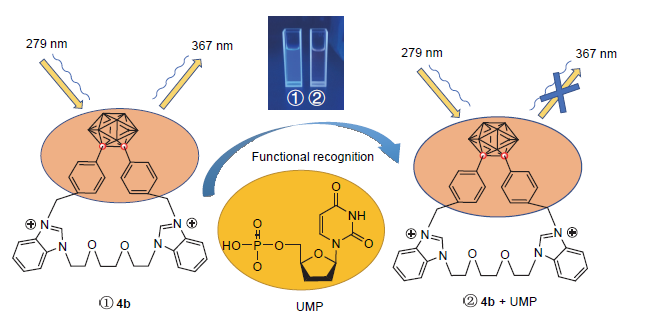| [1] |
Gella, A.; Ponce, J.; Cusso, R. and Durany, N. J. Physiol. Biochem. 2008, 64, 9.
doi: 10.1007/BF03168230
pmid: 18663991
|
| [2] |
Zhang, L. M.; Guo, L. E.; Li, X. M.; Shi, Y. G.; Wu, G. F.; Xie, X. G.; Zhou, Y.; Zhao, Q. H.; Zhang, J. F. Tetrahedron Lett. 2014, 55, 6131.
doi: 10.1016/j.tetlet.2014.09.074
|
| [3] |
Tumir, L. M.; Grabar, M.; Tomic, S.; Piantanida, I. Tetrahedron 2010, 66, 2501.
doi: 10.1016/j.tet.2010.01.063
|
| [4] |
(a) Olivari, M.; Montis, R.; Karagiannidis, L. E.; Horton, P. N.; Mapp, L. K.; Coles, S. J.; Light, M. E.; Gale, P. A.; Caltagirone, C. Dalton Trans. 2015, 44, 2138.
doi: 10.1039/C4DT02893G
pmid: 26207611
|
|
(b) Qiao, B.; Sengupta, A.; Liu, Y.; McDonald, K. P.; Pink, M.; Anderson, J. R.; Raghavachari, K.; Flood, A. H. J. Am. Chem. Soc. 2015, 137, 9746.
doi: 10.1021/jacs.5b05839
pmid: 26207611
|
|
(c) Toure, M.; Charles, L.; Chendo, C.; Viel, S.; Chuzel, O.; Parrain, J. L. Chem.-Eur. J. 2016, 22, 8937.
doi: 10.1002/chem.201601174
pmid: 26207611
|
| [5] |
(a) Lin, J. H.; Tseng, W. B.; Lin, K. C.; Lee, C. Y.; Chandirasekar, S.; Tseng, W. L.; Hsieh, M. M. ACS Sensors 2016, 1, 1132.
doi: 10.1021/acssensors.6b00425
|
|
(b) Lu, S. H.; Phang, R. P.; Fang, J. M. Org. Lett. 2016, 18, 1724.
doi: 10.1021/acs.orglett.6b00311
|
| [6] |
Li, X. Y.; Zhao, Z. X.; Hu, L. H.; Wei, D. C.; Liu, Q. X. Chin. J. Org. Chem. 2021, 41, 3608. (in Chinese)
doi: 10.6023/cjoc202103011
|
|
(李芯颖, 赵志翔, 胡林海, 魏登澈, 柳清湘, 有机化学, 2021, 41, 3608 )
doi: 10.6023/cjoc202103011
|
| [7] |
Zhou, J.; Yuan, Y. F.; Zhuo, J. B.; Lin, C. X. Tetrahedron Lett. 2018, 59, 1059.
|
| [8] |
Fuentes, I.; Garcia-Mendiola, T.; Sato, S.; Pita, M.; Nakamura, H.; Lorenzo, E.; Teixidor, F.; Marques, F.; Vinas, C. Chem.-Eur. J. 2018, 24, 17239.
doi: 10.1002/chem.201803178
pmid: 30222214
|
| [9] |
Ahmed, N.; Shirinfar, B.; Youn, I. S.; Bist, A.; Suresh, V.; Kim, K. S. Chem. Commun. 2012, 48, 2662.
doi: 10.1039/c2cc17145g
|
| [10] |
Liu, K.; Zhang, J.; Xu, L.; Liu, J.; Ding, L. P.; Liu, T. H.; Fang, Y. Chem. Commun. 2019, 55, 12679.
doi: 10.1039/C9CC06771J
|
| [11] |
Cao.; Xinxin Zhao.; Wenge Yang. Dyes Pigm. 2019, 160, 48. (a) Huace Sheng.; Yonghong Hu.; Yi Zhou.; Shimin Fan.; Yang Cao.; Xinxin Zhao.; Wenge Yang. Dyes Pigm. 2019, 160, 48.
doi: 10.1016/j.dyepig.2018.07.036
|
|
(b) Dai, Y. P.; Xu, K. X.; Wang, C. Y.; Liu, X. Y.; Wang, P. Supramol. Chem. 2017, 29, 315.
doi: 10.1080/10610278.2016.1228935
|
|
(c) Wang, P.; Fu, J. X.; Yao, K.; Chang, Y. X.; Xu, K. X.; Xu, Y. Q. Sens. Actuators, B 2018, 273, 1070.
doi: 10.1016/j.snb.2018.07.028
|
| [12] |
(a) Dai, Y. P.; Xu, K. X.; Wang, C. Y.; Liu, X. Y.; Wang, P. Supramol. Chem. 2017, 29, 315.
doi: 10.1080/10610278.2016.1228935
|
|
(b) Wang, P.; Fu, J. X.; Yao, K.; Chang, Y. X.; Xu, K. X.; Xu, Y. Q. Sens. Actuators, B 2018, 273, 1070.
doi: 10.1016/j.snb.2018.07.028
|
| [13] |
Bitter, I.; Torok, Z.; Csokai, V.; Grun, A.; Balazs, B.; Toth, G.; Keseru, G. M.; Kovari, Z.; Czugler, M. Eur. J. Org. Chem. 2001, 2001, 2861.
doi: 10.1002/1099-0690(200108)2001:15<2861::AID-EJOC2861>3.0.CO;2-S
|
| [14] |
(a) Adam, A.; Haberhauer, G. Chem.-Eur. J. 2017, 23, 12190.
doi: 10.1002/chem.201701096
pmid: 16018672
|
|
(b) Hausner, S. H.; Striley, C. A. F.; Krause-Bauer, J. A.; Zimmer, H. J. Org. Chem. 2005, 70, 5804.
pmid: 16018672
|
| [15] |
Wang, J. C.; Yuan, Y. F.; Zhuo, J. B.; Yang, S. H.; Lin, F. Chem. J. Chin. Univ. 2018, 39, 889. (in Chinese)
|
|
(王吉成, 袁耀锋, 卓继斌, 杨思涵, 林芬, 高等学校化学学报, 2018, 39, 889.)
|
| [16] |
Dong, L. R.; Wang, S. Y.; Zhang, X. M.; Cheng, J. J.; Yuan, Y. F. Chem. J. Chin. Univ. 2019, 40, 927. (in Chinese)
|
|
(董丽蓉, 王思雨, 张小媚, 成佳佳, 袁耀锋, 高等学校化学学报, 2019, 40, 927.)
|
 ), 袁耀锋a,*(
), 袁耀锋a,*( )
)
 ), Yaofeng Yuana(
), Yaofeng Yuana( )
)
